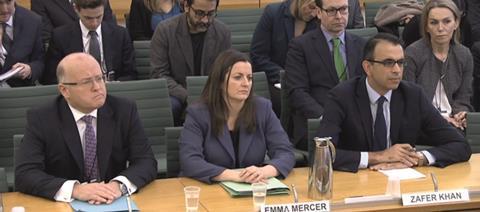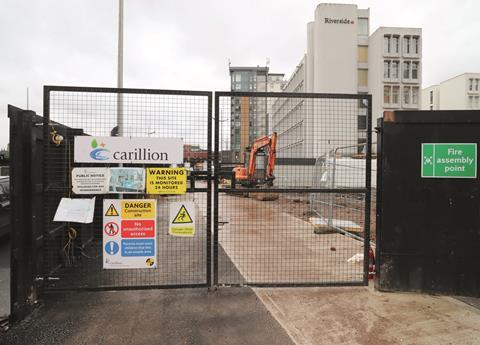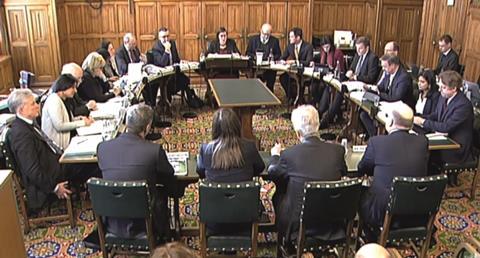Befuddled by the sheer volume of information coming out about CarillionŌĆÖs collapse? HereŌĆÖs what we know, what we donŌĆÖt know and what we still need to know

The stocks may have been officially abolished as a form of punishment in England in 1837, but the inquiry by MPs into the collapse of Carillion has shown that its modern-day equivalent ŌĆō the select committee evidence session ŌĆō is still in rude health. Last week CarillionŌĆÖs auditors and the pensions regulator were the latest to go in front of MPs for the ritualised humiliation for their perceived part in the downfall of the ┬Ż5bn turnover contracting giant.
But for all the heat generated by the ill-tempered exchanges between witnesses and MPs, what light has the inquiry so far shed on what happened to cause its collapse on 15 January? More than 100 letters and documents containing tens of thousands of words have been published since the inquiry began. Three very public evidence sessions have heard hours of testimony under aggressive cross-examination from key players, including senior officers of the firm such as former chief executives Keith Cochrane and Richard Howson, as well as regulators and auditors.
So, have we learned anything from this, what facts are still in dispute, and what questions remain unanswered?
[failure to disclose about the need for a profit warning] may have amounted to a dishonest concealment of a material fact
Kiltearn Partners
1. What weŌĆÖve learned
In short, surprisingly littleŌĆ”
Contracts, timings and explanations
We do at least have spoken confirmation, from former finance director Zafar Khan, that the three UK contracts that hit Carillion hardest were the Aberdeen Western Peripheral Bypass, the Royal Liverpool hospital and the Midland Metropolitan hospital, while internationally it was the Downton Doha project for Msheireb Properties in Qatar that Carillion directors blamed for the most serious problems, alongside two Canadian railway station projects. All the directors giving evidence to the committee maintained that serious problems only emerged on these contracts between the time of its AGM on 3 May 2017 and the announcement of its devastating profit writedown on 10 July. Former chair Philip Green said ŌĆ£everyone was surprisedŌĆØ by the extent and speed of the deterioration in the contracts over such a short period. He also made clear he felt Carillion went into 2017 with debt too high ŌĆō as did Khan in a subsequent letter to the select committee chairs ŌĆō but few of the other senior officers of the company could think of anything concrete that should have been done differently. Richard Howson, chief executive from 2011 to July 2017, said bidding for the Aberdeen bypass was a mistake. The joint inquiry chairs, MPs Rachel Reeves and Frank Field, branded the directors ŌĆ£delusionalŌĆØ after their testimony.
July profit warning
Interim chief executive Keith Cochrane increased the ┬Ż845m 10 July profit warning by ┬Ż150m from ┬Ż695m the day before it was presented to the City, in consultation with his auditors, in order to ŌĆ£materially de-riskŌĆØ the business for investors. Cochrane said he was only told the approximate size of the contract provision at the end of June. This figure was generated by a review of major contracts by CarillionŌĆÖs auditor KPMG, which internal auditor Michael Jones of Deloitte said in a number of cases ŌĆ£took a more pessimistic viewŌĆØ of those contracts than the original project appraisals had done.
Pension fund dispute
Evidence from the chair of CarillionŌĆÖs pension fund trustees, Robin Ellison, shows a lengthy disagreement between the trustees and the firm over the contributions required to set the pension fund back on a sustainable footing. When Carillion went under, its pensions schemes had a deficit of nearly ┬Ż600m. EllisonŌĆÖs evidence shows the trust disputed the payment plan Carillion had in place to secure the pension on each of the three times it was valued from 2008. Twice Carillion imposed a payment plan on the pension trustees without agreement being reached, but while the Pensions Regulator was ŌĆ£proactively engagedŌĆØ in the discussions, it ultimately did not use its statutory powers to ensure Carillion paid more. This was despite the fact Carillion was increasing its dividends to shareholders in the period. The trustees were asking for ┬Ż65m per year to address the deficit, but the company offered just ┬Ż33.4m. Minutes of a meeting between the trustees and the Pensions Regulator recorded Ellison saying that Carillion finance director Richard Adam felt funding the pension scheme was a ŌĆ£waste of money.ŌĆØ

Dissatisfaction of major shareholders
Investment bank Standard Life Aberdeen, which had held 10% of Carillion shares, told MPs that it started selling the stock in 2015, 18 months before the profit warning, because of ŌĆ£the companyŌĆÖs strategy, its vulnerability to worsening market conditions and [ŌĆ”] the strength of its balance sheetŌĆØ. It said Carillion held high levels of debt, had a widening pension fund deficit, narrowing margins, weak cash generation and wasnŌĆÖt listening when investors raised concerns.
At that time, investor Kiltearn Partners was continuing to buy shares on the basis of published information and reassurances from Carillion executives, with the firm owning 10% of shares by February 2017. Kiltearn started selling following the profit warning. It told MPs it believes there are ŌĆ£clear grounds for an investigation into whether CarillionŌĆÖs management knew, or should have knownŌĆØ, about the need for the profit warning earlier than July 2017, and that a failure to disclose ŌĆ£may have amounted to a dishonest concealment of a material factŌĆØ by directors. Kiltearn said it would have considered taking legal action on this basis against Carillion, had it not gone into liquidation.
Why it finally went under
Cochrane told MPs the business had a clear path for survival and recovery ŌĆō including the recovery of more than ┬Ż250m in claims ŌĆō but that it was undone by the failure of efforts to secure ŌĆ£additional short-term funding to help facilitate and ensure a longer-term solutionŌĆØ. In particular, he said Carillion was aiming to secure ┬Ż160m of ŌĆ£supportŌĆØ from government ŌĆō described as a bailout by committee chair Frank Field MP ŌĆō until a wider restructuring was secured. Carillion fell when the government ultimately turned down that 13 January request.
But for a few very challenging contracts [ŌĆ”] I believe Carillion would have survived
Richard Howson, Carillion
2. WhatŌĆÖs still disputed?
Quite a lotŌĆ”
Dispute in Doha
Interim chief executive Cochrane and former chief executive Howson both said the failure to be paid for work on the Downtown Doha scheme for Msheireb Properties, won in 2011, was a major part of the firmŌĆÖs downfall. Howson said: ŌĆ£But for a few very challenging contracts, predominantly in the Oman and one in Qatar, I believe Carillion would have survived.ŌĆØ But much about it remains disputed or unclear. Howson told MPs claims had been lodged by Carillion as early as the start of 2015 in four separate disputes with the client. While two of these were settled in summer 2016, allowing cash briefly to start flowing, Howson said Msheireb owed ┬Ż200m at the point he left Carillion at the end of 2017. He said he had been visiting Qatar 10 times a year for six years to collect money and ŌĆ£felt like a bailiffŌĆØ, and that performance bonds signed up to by Carillion meant the contractor couldnŌĆÖt walk away without forfeiting them. However, Msheireb has said since in a statement that it continued to pay Carillion during the period and that, moreover, Carillion failed to pass this cash on to its suppliers, causing the client to incur more costs.
Moreover, HowsonŌĆÖs testimony doesnŌĆÖt fully explain why auditors were happy to sign off previous accounts in which Carillion made no provision for potential losses on the scheme, despite the long history of payment difficulties. Howson told the committee the decision to make a provision was finally made in June when Msheireb appointed an alternative contractor to finish the job. Peter Meehan, CarillionŌĆÖs auditor at KPMG, told MPs the firm stood by its audits. ŌĆ£In December we did our audit [of the 2016 accounts] and signed the accounts on 31 March based on the facts we were aware of at that time,ŌĆØ he said.
When did the Royal Liverpool become a problem?
Carillion executives insisted to MPs that contracts only began to deteriorate noticeably from May last year. Howson said that the ┬Ż335m Royal Liverpool contract specifically deteriorated in Q2 last year, after the discovery of eight cracked beams during testing that added more than ┬Ż20m to completion costs. He said: ŌĆ£There were eight cracked beams that needed remedial works, and it took us two months to ascertain that. It then took us four or five months to do the remedial works.ŌĆØ
However, in a letter to the committee, Charles McLeod at the PFI schemeŌĆÖs client, Hospital Company (Liverpool), said the first two cracked concrete beams were discovered as far back as November 2016. Six further beams were only discovered later, but problems on those were ŌĆ£less significantŌĆØ. The local press reported the beam cracks in December 2016, and was already reporting a year delay to the scheme at the end of March 2017, five weeks before Carillion executives told MPs that they became aware of significant contract problems, and three-and-a-half months prior to the profit warning.
In addition, McLeod said the cost of remedial works are being borne principally by the subcontractors responsible for the beam design, manufacture and installation, Heyrod Construction and Freyssinet, while liability is established, rather than Carillion. He did say that monthly payments to Carillion were reduced to cover a proportion of the costs of the remedial work.

How aggressive was CarillionŌĆÖs accounting?
Carillion has been accused of being aggressive in its interpretation of accounting rules, which allow flexibility in reporting profit and revenue. Its final group finance director, Emma Mercer, who was promoted to the role in September after four years working for the firm in Canada, told MPs that she found the firm operating a ŌĆ£slightly more aggressive trading of contractsŌĆØ on her return to the UK. Asked if she was inheriting aggressive accounting practices from her predecessors, Khan and Adam, Mercer said: ŌĆ£They were more aggressive in tone than what I had seen in the UK previously.ŌĆØ She said this meant that when troubles hit ŌĆ£because we were already at a more aggressive position, it was very difficult to withstand those deteriorations on those projects.ŌĆØ This week MPs saw minutes from a board meeting in May revealing that Mercer blew the whistle on the way accounts had been kept before she took the FD post.
However, Khan denied operating ŌĆ£aggressiveŌĆØ accounting practices, telling MPs: ŌĆ£I do not agree that there was a concerted effort to adopt aggressive accounting [ŌĆ”] the numbers that were reported in March 2016 were appropriate, based on the information that was available at that point in time.ŌĆØ Adam was not asked specifically about aggressive accounting policies, but told MPs the process in place during his tenure were appropriate. ŌĆ£I do not think I produced data that misled my colleagues. I think the financial data that was presented to the board was fulsome. I believe that it was reported in a very transparent and open way,ŌĆØ he said.
Because we were already at a more aggressive position, it was very difficult to withstand those deteriorations on those projects
Emma Mercer, Carillion

3. Questions remaining
The big question so far unanswered is why Carillion did not notify anyone of the problems on any of its contracts until July 2017, despite a number of the issues being known for some time. Cochrane said cash flows only starting being hit in May 2017, prompting the KPMG contract review that led to the profit warning. But according to HowsonŌĆÖs testimony, Carillion had been experiencing problems with being paid for work on Downtown Doha from at least the start of 2015, and, likewise, the problems at the Royal Liverpool started well before the profit warning. In addition, MPs have asked why losses on the Aberdeen bypass were not made public earlier, given CarillionŌĆÖs JV partner Galliford Try made provision for them at the start of 2017, six months before Carillion did. All this is even more perplexing given Cochrane testified ŌĆ£the board was aware of specific challenges around particular contract positionsŌĆØ on which it ŌĆ£received a quarterly financial updateŌĆØ from when he joined the business in September 2015.
Questions also remain over how far regulators feel Carillion and its directors and advisers have a case to answer. Stephen Haddrill, chief executive of the Financial Reporting Council (FRC), which is formally investigating the audit of Carillion by KPMG, said the FRC will look into ŌĆ£how the directors reached the decisions that they took, particularly towards the end of the last financial yearŌĆØ and that ŌĆ£we all look at what has happened with a degree of incredulityŌĆØ. However, the FRC will only decide whether to prosecute once its investigation is complete, and it hasnŌĆÖt yet decided whether to even investigate the actions of accountants working within Carillion itself. Likewise, Insolvency Service chief executive Sarah Albon said the body was ŌĆ£preparing a case to bring to courtŌĆØ and would be ŌĆ£looking at the treatment of any dividends, any payments into the pension scheme, the levels of remuneration ŌĆ” in the context of the failures of the companyŌĆØ, but that it was too early to say how long any of this will take.




























No comments yet